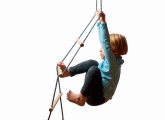Early years consultant Carol Skinner explains how to use your sand and water table to stimulate children’s understanding of maths…
Sand and water are wonderful mediums to use to develop children’s maths knowledge, skills and understanding. Playing with them involves, amongst other things, investigating, experimenting, constructing and problem-solving – and, lest we forget, it can be lots of fun.
The maths content in the Early Years Foundation Stage Framework is about understanding number and calculation, becoming familiar with measuring and working with shapes and solving problems.
We all know that children are constantly trying to put their ideas and theories to the test by hands-on ‘doing’, and the presence of sand or water gives them the opportunity to do just that.
As they play with the sand and water, children acquire and practise new maths skills – from counting how many plastic fish they managed to net, to deciding the best bucket to use to make the largest sand pie, just the sort of activities that give children opportunities to count and measure, and to find out about shapes in a meaningful way.
As such there need to be plenty of opportunities for children to experiment with the sand and water, and to have opportunities to make decisions about what equipment to use and how to use it.
You will need to spend time preparing the environment, including the physical space, selecting and gathering props and displaying them in a way that invites their use.
You can encourage children’s independence and responsibility by expecting the children to share equipment and take turns.
Put in place strategies that support children in playing cooperatively and learning to be active members of the group or pair when they are using the sand or water.
You should supply additional materials to extend their experiences as well as model uses for particular props by playing alongside and demonstrating how to use a funnel or a rake.
It’s a good idea to make sure there are at least a couple of small dustpans and brushes or mops and buckets nearby so that children can be involved in clearing up.
Wet and dry sand have very different properties, so the children need to experiment with and experience both types, as well as occasionally adding lots of water to turn the sand into very wet sloppy sand.
Whether the sand is damp or dry it should be deep enough to dig, scoop or sieve with – children really do need to be able to fill two or three containers each without running out of sand.
You should provide a good variety of equipment (hanging close by is better than cluttering up the sand tray). Include some natural materials such as shells, drift wood and small stones that can be mixed into the sand or used to embellish sand constructions.
Make sure there is a range of different-sized plastic combs, shapes and small sticks for pattern making. Introduce lentils, rice, small buttons or counters to make the sand gritty and then sieve them out.
Sometimes children should have access to sand in small containers and shallow trays on a tabletop as well as in a conventional sand and water table. On these occasions, provide miniature equipment such as measuring spoons, tea strainers and egg cups.
Children should be able to experience digging in a large amount of sand in an outdoor sandpit or at the very least a tarpaulin on the ground filled with sand – something they can walk on barefoot. A large tyre or plastic paddling pool filled with sand can make a quick instant outdoor sand pit.
The mathematically good things children do when they play with sand include lining things up, counting them, making patterns, comparing sizes and using moulds and containers, burying treasure and digging it up again. You should encourage the following play activities to maximise maths learning:
1. Counting how many spoonfuls, shovelfuls or handfuls it takes to fill a container
2. Lining up and counting how many objects have been found in a sieve
3. Making handprints in the sand and then making one more
4. Arranging a row of full containers and nearly full containers
5. Pressing shapes in damp sand to make a pattern
6. Sieving out beads, small pebbles and large sequins and finding the total
7. Sorting the sand tools into things to dig with and containers to fill
8. Using a stick to draw a very, very long line in the sand
9. Observing how quickly/slowly the sand flows through a sieve
10. Filling and emptying containers and using size language
● Together make a line of five sand castles and then increase the number to 10 castles.
● Use damp sand and four different shaped containers to make some 3D shapes. Challenge the children to say which container made which shape.
● Make two sand pies and discuss what’s the same and what’s different about them.
● Bury seashells, stones and other small objects in the sand to find, count, sort and classify. Record by drawing or photos how many of each type have been dug up.
Children enjoy playing with water. When they are investigating it they will have much more fun, and learn much more, if they have access to water both indoors and outside. The indoor sand and water table should be as large as space allows – transparent trays are a good choice, as children can see changes of water colour and whether objects are really sinking or just hovering halfway between the surface and the bottom of the tray – whilst the outdoor water should include, if at all possible, a hose, some watering cans and plastic guttering and pipes.
Simple changes can add new experiences such as warm water, ice cubes, chopped jelly, food colouring and sometimes bubbles. Buy a sack of shells from a garden centre to put in the water and add different perfumes with bath salts.
The properties of water that we want young children to experience, recognise and discuss can also help them develop maths knowledge and skills. Of course, a lot of the activity at the sand and water table will involve pouring and measuring, but ask open-ended questions such as, “I wonder if that amount will fit in this jug?” or “Will the water stay in a sieve?” or “What’s the best way to find out which cup holds the most?”
Support children in developing pouring skills – use funnels where needed. As their skills increase, show how to mark the water level by using an elastic band around the container.
When children are playing with water there are lots of additional ideas and resources you can provide that will enhance their mathematical play, including collecting and measuring snow and rainwater, looking at reflections in puddles and dissolving substances such as salt, sugar and soap flakes in water. You could also try encouraging the following play activities:
1. Sorting, counting and comparing objects that float
2. Counting how many pebbles were added to a small bucket of water before it spilt out
3. Netting slimy worms of cooked spaghetti and comparing their lengths
4. Using a hose to make water patterns on the ground
5. Squeezing plastic bottles to empty and fill them up
6. Deciding when a container is nearly half-full
7. Pouring water into a funnel to fill various containers
8. Showing where to hold the hose to make rainbows in the sun
9. Sorting into two sets the objects that float and those that sink
10. Filling containers until the water overflows and discussing what that means
● Put some plastic sea creatures in the sand and water table, add blue food colouring and use aquarium nets or strainers to catch the creatures put them in a bucket and count how many were caught. Release the creatures back to the sea once they have been counted.
● Pour water down a slope or gutter and decide if you make the slope steeper whether the water will run faster or slower
● Add bubble mixture to the sand and water table and sponge numerals. Invite the children to net a number, name it and match it to a plastic-covered number line.
● Pour some water onto a hard surface in the outdoor area to make a puddle. Measure how big it is by laying out and counting pebbles around the edge of the puddle. Discuss other ways of measuring its size.
● Investigate the way water spouts out of holes. Use a skewer to pierce holes in an empty plastic drink bottle. Make the holes in a circle around the bottle. Investigate tilting the bottle to switch the holes on and off. Next time make the holes in a different pattern.
Using sand and water play as part of a cross-curricular mini-project…
Carole Skinner is an independent early years consultant and founder associate of Early Education. She is the co-author of Foundations of Mathematics: An Active Approach to Number, Shape and Measures in the Early Years.

Boost children’s confidence by letting them try
Editors picks

Questioning – Supporting children to ask and answer
Editors picks
